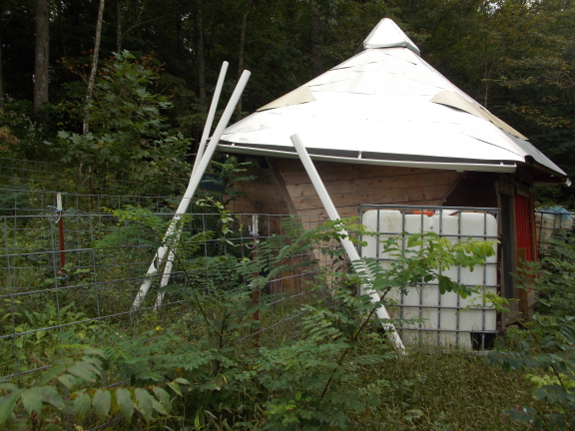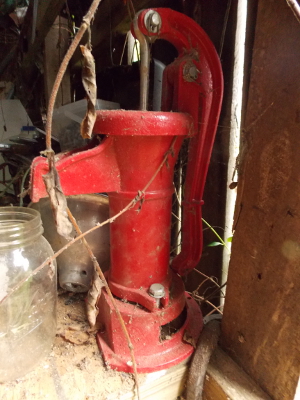
Planning for goat water

Several of you asked (or warned) about fencing for our upcoming goats.
I started to write a long post in reply about my complicated plans on
that front, but it seemed a little silly to theorize when I'll be able
to report on our trial and error in less than a month. However,
there is a goat-related conundrum we're currently trying to solve --- water.
We plan to house our new goats in our starplate coop,
but the structure is about 250 feet from the closest water source and
up a relatively steep hill. It was a bit wearying to carry a
five-gallon bucket to the coop once a week over the summer, so I can
only imagine how old the chore will get for goats (who presumably drink
more than chickens) during the winter months.
 We've
come up with several potential summer solutions, but winter ones will
require more industry. We can finish working up the gutters and rain-barrel system,
but the spigot is bound to freeze during the winter whether or not the
tank is big enough prevent the whole thing from freezing solid.
Similarly, we could pump water from the creek
into our IBC tanks, but our creek-line isn't buried and only sometimes
runs in the winter (and we'd still have to deal with a frozen spigot).
We've
come up with several potential summer solutions, but winter ones will
require more industry. We can finish working up the gutters and rain-barrel system,
but the spigot is bound to freeze during the winter whether or not the
tank is big enough prevent the whole thing from freezing solid.
Similarly, we could pump water from the creek
into our IBC tanks, but our creek-line isn't buried and only sometimes
runs in the winter (and we'd still have to deal with a frozen spigot).
Gene Logsdon posted a few
weeks ago about burying rain barrels to make mini-cisterns, and I think
the idea has potential in our starplate pasture. I love to dig,
especially at this time of year when garden work is winding down, and
the starplate earth is much lighter than the stuff in our core
homestead. Plus, Mark brought a hand-pump home from the hardware
store many moons ago, thinking we might need it if the world came to an
end, and we could use that to get water out of the buried rain barrel in
order to hydrate our herd.
But I have a feeling that
I'm missing something even more obvious. Ideas? How would
you water goats located far enough away from the house that extension
cords don't really reach?
Want more in-depth information? Browse through our books.
Or explore more posts by date or by subject.
About us: Anna Hess and Mark Hamilton spent over a decade living self-sufficiently in the mountains of Virginia before moving north to start over from scratch in the foothills of Ohio. They've experimented with permaculture, no-till gardening, trailersteading, home-based microbusinesses and much more, writing about their adventures in both blogs and books.
Want to be notified when new comments are posted on this page? Click on the RSS button after you add a comment to subscribe to the comment feed, or simply check the box beside "email replies to me" while writing your comment.

In my part of the country solar stock tank heaters are pretty common. You could also, depending upon your configuration, fairly easily wire up a bit of heat line/cable. There are various versions for roofs, gutters, pipes, water lines.
I don't remember if you've considered that in your past explorations or not, apologies for the duplicate if you have.
Basically it's a line that has high resistance so throws off some amount of heat instead of sending electricity much of anywhere. Many come with various regulators to match your needs. ie it only turns on once it senses a certain drop in temp or you set it to turn on every day from 6-7 am and run the water tank full and then let things cool again till you need it again. Assuming your water lines are drainback or capable of dealing with freeze thaw cycles.
Do you have enough sun for a flat black painted water barrel to give you enough thermal mass to take advantage of solar heating?
Perhaps a small scrap lumber and plastic greenhouse style setup around your water supply. Small PV setup to run a light bulb.
Keep the barrel inside the pen to utilize heat given off by the goats?
Any combination thereof. I wish I could be solving those kinds of problems with my days.
You can change the freezing point of water by adding e.g. sugar or table salt to it.
According to this, a solution of one part sugar on three parts water will start freezing at 26-27 F.
There are probably other salts (in the sense of reaction products of a base and an acid) that depress the freezing point as well. Maybe there are salts that goats can drink without problems?
I don't remember whether you are totally on solar or not - and this advice would be moot if you were - but when we lived in an RV, we made use of a serious, heavy-duty extension cord made to go a long distance. We used 2 cords that ended up going 150' - 200' and still held enough power to run the RV lights, fridge, radio, TV etc.
As I recall, the cords were somewhat expensive ($200?), and you had to be careful not to mow over them. But they held up in bad weather for 8 months.
Given all that expense, I would choose some other option, but it's good to know about.
Hydraulic ram pump from creek.
If you bury barrels, use a bucket to dip water out to trough once a day.